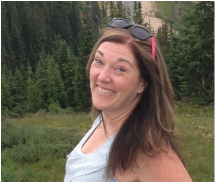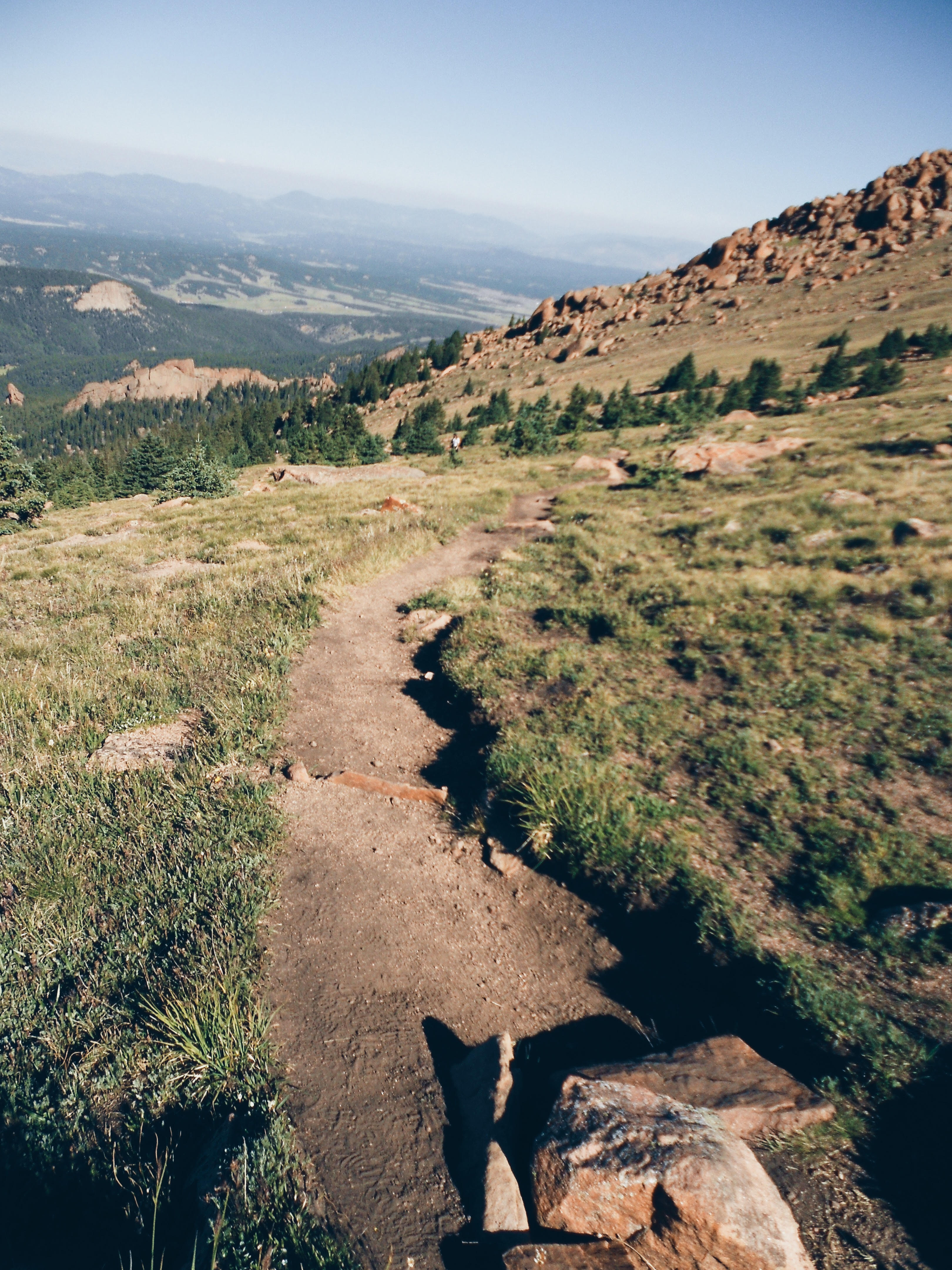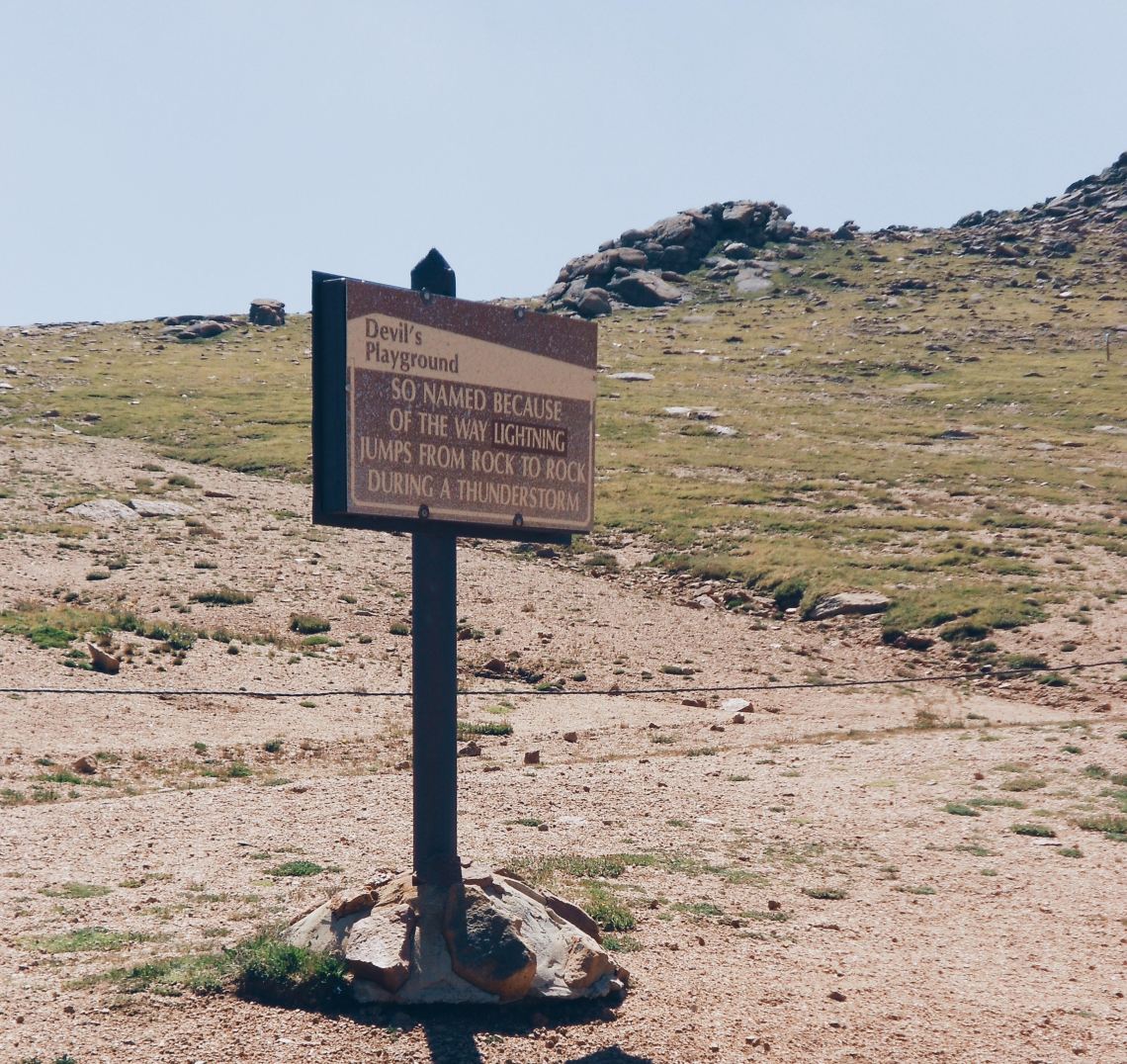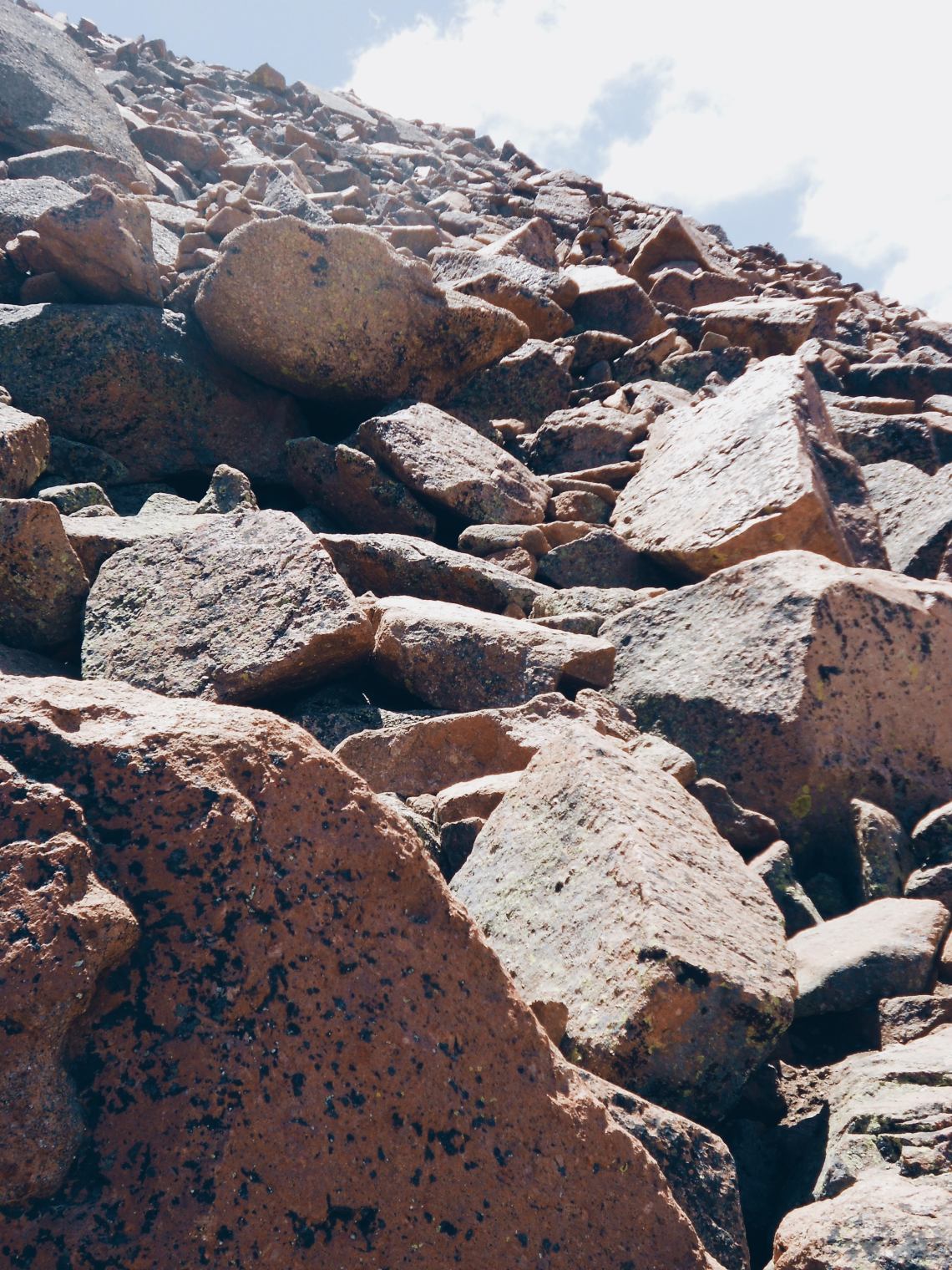Hiking 14ers, mountain peaks over 14,000 feet, is a sport in Colorado. Some climb the same mountain every year, counting time with each climb. Some work years, even decades, to climb all the 14ers in the state (there are 54).
These are not my people.
I run on a treadmill and walk in my neighborhood. I am not what anyone would call outdoorsy. So how did a city girl like me end up on a mountain trail at too-damned-early in the morning? If anyone asked, and they did, I would say something inane like I grew up here. I’ve always wanted to do it. I’m not getting any younger.
All true. I did grow up in the shadow of Pikes Peak, but I never felt the need to hike it. It was the backdrop of my personal story. Beautiful and distant, it defined the Western border of what I termed home. Yet here I am, pre-dawn, mid-July, with the cool mountain air no longer a backdrop but the setting of my story.
Two or three at a time, small groups check in with the hike organizer, loading their pockets with protein gels and Gatorade, before heading into the dense forest around Crags Trailhead. I sign in with another single mom and her twelve-year-old daughter. We are an unlikely group of adventurers.
Almost immediately, our path crosses a crude bridge before beginning a series of switchbacks up the ridge of a mountain. At a fork, a sign marks left to “the Crags” or right to “Devil’s Playground.” We follow the road less traveled to the Devil’s Playground. Beyond that, Pikes Peak reigns.
The air is absolutely still as the hike begins. The silent forest remains asleep, unaware of our intrusion. Reverent, we don’t speak the first mile, or maybe we’re just winded from the steady incline. The groups string out, hiking at different paces as we press through the deceptively easy start to the day. The shadow of the peak keeps the forest of pinion pine and juniper in darkness long past dawn. Insects wake first; they make a low trilling sound that mimics a snake’s rattle. The three of us are skittish at first, shying away from the sound until we identify the source. Soon after, mountain chickadees wake, chirping at the human invasion. A trickling stream gurgles as we skip over the smooth rocks to the other side before the trail intensity increases with a sudden incline that has us bunched into large groups as we stop more frequently on the steep mountainside.
The mood is jubilant as advanced hikers point out the names of peaks in the distance while the rest of us lean against convenient rocks and contemplate how far we’ve traveled in two short hours. One young man notes that the view “is why we’re here,” and his companion jokes, “if I die, just bury me here.” The groups stretch out like a coiled spring with faster groups taking the lead, then the spring contracts as they sit and wait for the slower members.
The protein gels become a necessary evil as we get shaky with exertion and headachy from the altitude. Everyone sips water from hydration packs that the organizers recommended, with two liters of water to get us to the top. The twelve-year-old supplements with Gatorade while complaining that she “thought this would be fun.” A hiker from New York falls back from the faster group as he struggles with the thinner air and higher altitude. He walks with us for a time, but once he reaches Timberline, he falls back from even the slowest hikers.
In the shadow of the peak for the first hours of the day, we now realize the full difficulty of the trail as we reach tree line. No shade. No cover. Alpine tundra coats the gravely ground like a net while purple wildflowers reach toward the sun with enviable determination. The constant zigzag of the switchbacks gets old, but we are too tired to blaze a new trail. We zig north; zag south, always up an incline, as the sun blazes with high altitude intensity. Experienced hikers recommend a swift climb up this stair-like slope, but the three women, as we are now called, rely on the old standard. Slow and steady.
If we are on our way to the Devil’s Playground, then this is Purgatory. Never ending, sun burning bare skin, hiking at an arduous angle. We press on because going back is not an option. The faster groups have left the slower. The flatland New Yorker falls from view as the ridgeline comes into sight. I run the last two hundred feet to the Devil’s Playground, fighting the extreme slope of the mountain.
I need to see what’s on the other side.
I need to be there alone.
A chill wind whips past my ears, sounding as though it were whistling through a cave. Nothing stops it here. There is nowhere to hide from it. The meadow is a soft green crater that slopes up to the rim of a valley. On the north side are red rock formations that remind me of a bulldog named Brumis.
Waiting for the rest of my group, I sit on an outcropping looking down on a high-mountain valley and realize this is why I am here. It is peaceful here, more so after enduring the climb. It is restful, but only before the next leg of the journey. It is symbolic of where I am in life. I need a rest stop; then I will have to move on.
Strong is what I am told that I am. I fear just the opposite. In the past several years, I buried my eldest brother, watched my sister endure cancer treatments, survived my own divorce only to watch my mother die. Life’s mini-traumas were like speed bumps on the road to full-fledged events. There was no time to recover between losses. After four years in my own purgatory, with a new demon tripping me at every zigzag of life’s switchbacks, I had lost sight of myself much as we have lost sight of the flatlander.
By August of last year, I needed. Something.
Fear forced me to commit to something big and bold, because the alternative—inertia—terrified me more. The day’s high-altitude, low-oxygen revelation was that I started this climb as a litmus test of my own strength. If I could do this, I could do anything, to include moving past the grief. Training to hike the Peak became my twelve-step return to the living. Get up, work, teach, hike, and in the process, learn to live in the moment and relegate the past to the past. On my journey to prove my strength, I grew stronger.
The clarity of this high mountain valley helped me to recognize how far I have come. I have grieved, I have endured, and I have moved on. When my friend and her daughter join me on my rock, I have regained my equilibrium. Insects fly inches above the tundra to form a wave of black over the ground. Wind whips at the short grasses while orange and yellow butterflies play in the wildflowers. This becomes one of those moments to live in.
After a snack of protein gel and water, we continue to the Devil’s Playground, a grouping of rock formations so named because of the way lightning jumps from formation to formation in a storm. It’s another easy hike that we mistake for “almost done.” The trail crosses the Pikes Peak Highway. Here, the slope increases and leads to a rocky hill, still mostly grass, but a foretaste of the rock feast to come.
The hike leaders have long since raced ahead to the finish. After five miles on the trail, we—the three women—realize that the stacked rocks (cairns) along the path are trail markers that occur at each turn of a switchback. We trudge from cairn to cairn, as the way becomes more rock than hill. Blocks of granite the size of tombstones litter the landscape, stacked as if a wayward child had thrown his blocks into a corner. The boulder field is the most difficult for me. I have a fear of heights, and the hand over foot climb from one granite slab to the next terrifies me in a way the hike did not. It is not a group hike anymore. I cannot worry about someone else when I am terrified that I won’t make it past this personal demon. This was supposed to be a class two hike, not rock climbing.
It is literally me against the mountain.
This, too, is why I came. I don’t want easy. It is this last challenge—after hours of hiking—which illustrates my strength. Not my physical strength, or athleticism, or even endurance. This determines if I have the will to push on despite the very real mountain in my path. I leave my friend and her daughter behind as I follow the cairns, looking only as far ahead as each signpost, before turning and seeking the next leg of my journey.
The contrast of the cool wind and my heated skin registers in some corner of my mind, while the more conscious part finds the next cairn in the pile. A flock of birds takes flight from an outcropping beneath me, and I realize how incredibly high I have climbed. Birds now wing into the air below. Then the path levels and dumps unceremoniously into the parking lot at the summit. My friend and her daughter join me moments later. We are too tired for the king-of-the-world screech as we look down at the mountain we have conquered. Instead, we stand in line for the obligatory picture before heading inside for an overpriced burger and the now famous donuts.
Sir Edmund Hillary said that we do not conquer the mountain, but ourselves. I conquered my fear and my inertia. I trampled my traumas underfoot. I learned what I needed to learn from the mountain. The different views of it are a matter of perspective. Pikes Peak is purple and majestic, from a distance. Mid-winter, it is snow-packed and pristine. Now, in the summer, up close for the first time, Pikes Peak is a mound of packed pink granite. It is barren in places, like an alpine desert. It isn’t necessarily pretty. Distance gives it a rosier glow, a purplish hue that glosses over the rough edges, steep grades, and challenging climate.
Life’s traumas are like that. Death and divorce and isolation are ugly and rough and challenging. They suck the oxygen from your life and leave you gasping for air. But the breathlessness is temporary. As we hike down the trail, the altitude diminishes, the oxygen returns, and the forest welcomes us into its comforting folds.
Like the mountain, life needs distance to give it a rosy glow. Training for the hike by getting onto the trails every weekend gave me that distance. The work forced me to move away from my grief and into action. The hike itself gave me perspective. I climbed the tombstone blocks, followed the nearly indiscernible path between the cairns, and learned the secrets of the mountain, to better appreciate the beauty that distance provides.
 BIO: Cindy Skaggs holds an MFA from Pacific Lutheran University’s Rainier Writing Workshop and an MA in Creative Writing from Regis University. She is the author of seven novels. Her essays have appeared in Progenitor Art & Literary Review (2015), Soundings (2016), and the Fredericksburg Literary Art Review (November 2018). She resides in Colorado where she is a college English professor.
BIO: Cindy Skaggs holds an MFA from Pacific Lutheran University’s Rainier Writing Workshop and an MA in Creative Writing from Regis University. She is the author of seven novels. Her essays have appeared in Progenitor Art & Literary Review (2015), Soundings (2016), and the Fredericksburg Literary Art Review (November 2018). She resides in Colorado where she is a college English professor.




